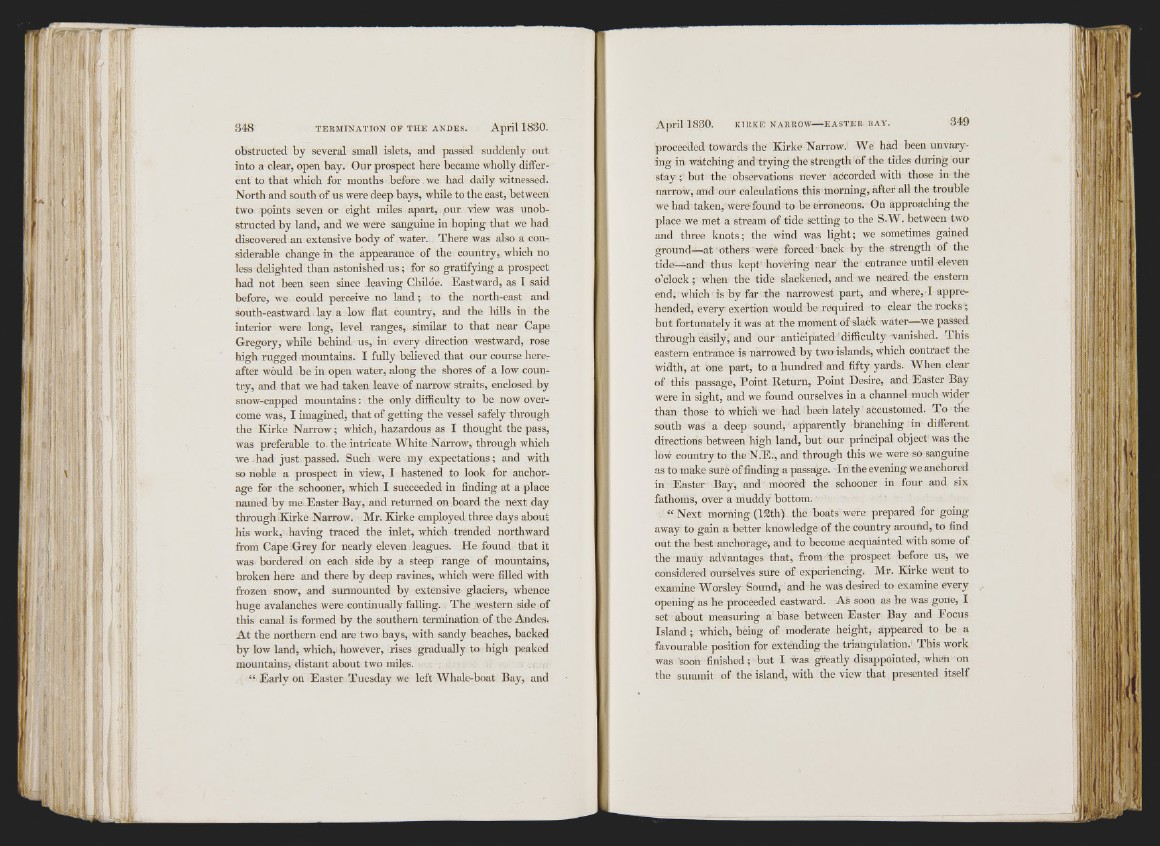
\ì I t ' f i
|i * ‘ I'
! iii i 7
348 T E RM IN A T IO N OF T H E ANDE S . April 1830.
obstructed by several small islets, and passed suddenly out
into a clear, open bay. Our prospect here became wholly different
to that which for months before we had daily witnessed.
North and south of us were deep bays, while to the east, between
two points seven or eight miles apart, our view was unobstructed
by land, and we were sanguine in hoping that we had
discovered an extensive body of water. There was also a considerable
change in the appearance of the country, which no
less delighted than astonished u s ; for so gratifying a prospect
had not been seen since leaving Chiloe. Eastward, as I said
before, we could perceive no land; to the north-east and
south-eastward lay a low flat country, and the hills in the
interior were long, level ranges, similar to that near Cape
Gregory, while behind us, in every direction westward, rose
high rugged mountains. I fully believed that our course hereafter
would be in open water, along the shores of a low country,
and that we had taken leave of narrow straits, enclosed by
snow-capped mountains: the only difficulty to be now overcome
was, I imagined, that of getting the vessel safely through
the Kirke Narrow; which, hazardous as I thought the pass,
was preferable to. the intricate White Narrow, through which
we had just passed. Such were my expectations; and with
so noble a prospect in view, I hastened to look for anchorage
for the schooner, which I succeeded in finding at a place
named by me Easter Bay, and returned on board the next day
through Kirke Narrow. Mr. Kirke employed three days about
his work,' having traced the inlet, which trended northward
from Cape Grey for nearly eleven leagues. He found that it
was bordered on each side by a steep range of mountains,
broken here and there by deep ravines, which were filled with
frozen snow, and surmounted by extensive glaciers, whence
huge avalanches were continually falling. The western side of
this canal is formed by the southern termination of the Andes.
At the northern end are two bays, with sandy beaches, backed
by low land, which, however, rises gradually to high peaked
mountains, distant about two miles.
“ Early on Easter Tuesday we left Whale-boat Bay, and
April 1830. KIRK E NARROW E A S T E R BAY. 349
proceeded towards the Kirke Narrow. We had been unviuy-
ing in watching and trying the strength of the tides during our
stay; but the observations never accorded with those in the
narrow, and our calculations this morning, after all the trouble
we had taken, were found to be erroneous. On approaching the
place we met a stream of tide setting to the S-W. between two
and three knots; the wind was light; we sometimes gained
ground—at others were forced hack by the strength of the
tide— and thus kept hovering near the entrance until eleven
o’clock; when the tide slackened, and we neared the eastern
end, which is by far the narrowest part, and where, I apprehended,
every exertion would be required to clear the rocks;
but fortunately it was at the moment of slack water—we passed
through easily, and our anticipated difficulty vanished. This
eastern entrance is narrowed by two islands, which contract the
width, at one part, to a hundred and fifty yards. When clear
of this passage. Point Return, Point Desire, and Easter Bay
were in sight, and we found ourselves in a channel much wider
than those to which we had been lately accustomed. To the
south was a deep sound, apparently branching in different
directions between high land, lint our principal object was the
low country to the N.E., and through this we were so sanguine
as to make sure of finding a passage. In the evening we anchored
in Easter Bay, and moored the schooner in four and six
fathoms, over a muddy bottom.
“ Next morning (12th) the boats were prepared for going
away to gain a better knowledge of the country around, to find
out the best anchorage, and to become acquainted with some of
the many advantages that, from the prospect before us, we
considered ourselves sure of experiencing. Mr. Kirke went to
examine Worsley Sound, and he was desired to examine every
opening as he proceeded eastward. As soon as he was gone, I
set about measuring a base between Easter Bay and Focus
Island; which, being of moderate height, appeared to be a
favourable position for extending the triangulation. This work
was soon finished; but I was greatly disappointed, when on
the summit of the island, with the view that presented itself
Si
IK I
II
i*
* 111
ft
1IÜ